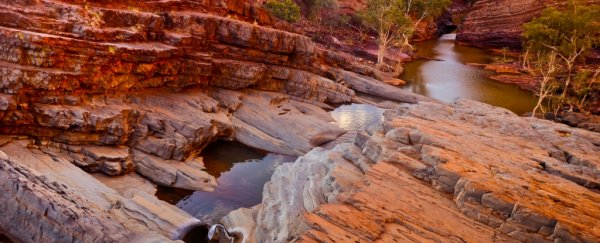Earth's continents are constantly on the move, it's a key feature of our planet, but that wasn't always the case.
While some scientists think Earth's tectonic plates began pushing and pulling only a billion years ago, others think the whole process started nearly four billion years ago, when our planet was but an infant.
That's quite the discrepancy, and as usual, general agreement lies somewhere in between. Today, it's commonly thought Earth's tectonic plates began moving around 2.8 billion years ago, when the interior of our planet was just the right temperature to allow for the formation of 15 rigid plates.
Even still, disagreement reigns. Direct evidence from this time is hard to come by, and now some of the oldest rocks on Earth suggest we may have been more than 400 million years off the mark.
Analysing magnetism in ancient rocks from Australia and South Africa, researchers at Harvard and MIT claim tectonic plates were moving at least 3.2 billion years ago and maybe earlier.
"Basically, this is one piece of geological evidence to extend the record of plate tectonics on Earth farther back in Earth history," says Alec Brenner, who researches paleomagnetics at Harvard University.
"Based on the evidence we found, it looks like plate tectonics is a much more likely process to have occurred on the early Earth and that argues for an Earth that looks a lot more similar to today's than a lot of people think."
The Pilbara craton in Western Australia is one of the oldest slices of Earth's ancient crust and contains fossils for some of the earliest organisms on our planet. Stretching nearly 500 kilometres across (300 miles), this chunk of primordial crust was formed as early as 3.5 billion years ago.
Drilling into a portion of this craton, known as the Honeyeater Basalt, researchers used state of the art magnetometers and demagnetising equipment to uncover the region's magnetic history.
Roughly 3.2 billion years ago, their data reveals a shift from one point to another, a latitudinal drift of 2.5 centimetres a year.
Or, as the authors put it, "a velocity comparable with those of modern plates."
"It's very comparable to the speeds of plate motion that we can see happening on the modern Earth," earth scientist Alec Brenner from Harvard told MSN.
"It's also the oldest example that we know of in which a piece of Earth's crust drifted long distances over the surface."
But that's about all they can say for now. While it's clear these rocks experienced some sort of horizontal movement, it's unclear if that shift was due to local effects or the rotation of the Pilbara craton as a whole. It could even be a combination of both.
There's actually a hypothesis that, in the beginning, Earth's tectonic plates moved in episodes of stops and starts that lasted for several billion years before more modern tectonic movements began.
This could be an explanation for the movement in Pilbara between 3.35 and 3.18 billion years ago, although the authors think the timing hints otherwise.
Still, while it's true the data could support episodic movements rather than gradual plate motion, geophysicist Stephan Sobolev, who was not involved in the study told Science News there is another explanation.
Some regions of crust may have started to move and subduct earlier than other areas, broken apart by meteorites or some other powerful force.
Given how quickly East Pilbara was moving, however, even Sobolev admits "large-scale subduction must have been involved".
There was clearly something big happening here, and if that something is widespread tectonic movement, that has important repercussions for the formation of habitats and life on Earth.
It also could apply to other planets out there.
"Currently, Earth is the only known planetary body that has robustly established plate tectonics of any kind," explains Brenner.
"It really behooves us as we search for planets in other solar systems to understand the whole set of processes that led to plate tectonics on Earth and what driving forces transpired to initiate it.
"That hopefully would give us a sense of how easy it is for plate tectonics to happen on other worlds, especially given all the linkages between plate tectonics, the evolution of life and the stabilization of climate."
The study was published in Science Advances.
